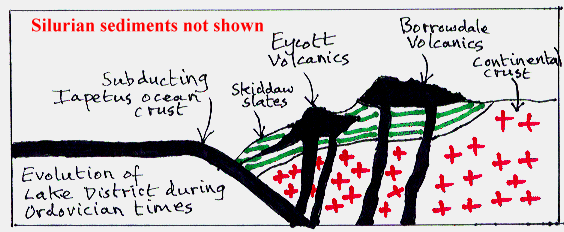Ordovician(510-439 Ma.) and
Silurian (439-408 Ma.) ( Lower Palaeozoic) times. Part 2 of 3
|
|
Subsequently, during Middle and Late Ordovician
times, ocean crust began to be subducted beneath
the Avalonian continent. This resulted in volcanic activity.
The volcanic rocks consisting mainly of andesite lavas and tuffs are, with
the exception of the Eycott Volcanics,
exposed in the central part of the Lake District and provide some of the most
dramatic scenery of the area. They are collectively known as the Borrowdale Volcanic Group. |
||||||||||||||||
|
During Silurian times volcanic activity ceased and
deep water graptolitic mudstones, siltstones and greywackes,
were deposited in the now closing Iapetus Ocean.
These sediments, the Windermere Group, can now be seen in the southern part
of the Lake District, e.g. around Lake Windermere. They provide a gentler
type of scenery in contrast to the Borrowdale Volcanics. |
|
||||||||||||||||
|
|
|
||||||||||||||||

